2000 YAMAHA XJ900S tires
[x] Cancel search: tiresPage 35 of 97

4-1
4
EAU01114
4-PRE-OPERATION CHECKSOwners are personally responsible for their vehicle’s condition. Your motorcycle’s vital functions can start to deteriorate
quickly and unexpectedly, even if it remains unused (for instance, if it is exposed to the elements). Any damage, fluid leak or
loss of tire pressure could have serious consequences. Therefore, it is very important that, in addition to a thorough visual in-
spection, you check the following points before each ride.
EAU00340
PRE-OPERATION CHECK LIST
ITEM CHECKS PAGE
Front brake• Check operation, free play, fluid level and fluid leakage.
• Fill with DOT 4 brake fluid if necessary.
6-19 ~ 6-21
Rear brake• Check operation, free play, fluid level and fluid leakage.
• Fill with DOT 4 brake fluid if necessary.
Clutch• Check operation condition and free play.
• Adjust if necessary.6-18
Throttle grip and housing• Check for smooth operation.
• Lubricate if necessary.6-14, 6-21
Engine oil• Check oil level.
• Fill with oil if necessary.6-8 ~ 6-10
Final gear oil• Check for leakage. 6-11
Wheels and tires• Check tire pressure, wear and damage. 6-15 ~ 6-18, 6-27 ~ 6-31
Control and meter cables• Check for smooth operation.
• Lubricate if necessary.6-21
Brake and shift pedal
shafts• Check for smooth operation.
• Lubricate if necessary.6-22
Brake and clutch lever
pivots• Check for smooth operation.
• Lubricate if necessary.6-22
Center and sidestand
pivots• Check for smooth operation.
• Lubricate if necessary.6-22
Page 46 of 97

6
PERIODIC MAINTENANCE AND MINOR REPAIR
Tool kit................................................................... 6-1
Periodic maintenance and lubrication ................... 6-2
Cowling removal and installation .......................... 6-5
Cowling A.............................................................. 6-5
Cowling B.............................................................. 6-6
Spark plug inspection ........................................... 6-7
Engine oil .............................................................. 6-8
Final gear oil replacement .................................. 6-11
Air filter ............................................................... 6-11
Carburetor adjustment ........................................ 6-13
Idle speed adjustment ........................................ 6-13
Throttle cable free play inspection ...................... 6-14
Valve clearance adjustment ................................ 6-14
Tires .................................................................... 6-15
Wheels ................................................................ 6-18
Clutch lever free play adjustment........................ 6-18
Brake light switch adjustment ............................. 6-19
Checking the front and rear brake pads.............. 6-19
Inspecting the brake fluid level............................ 6-20Brake fluid replacement ..................................... 6-21
Cable inspection and lubrication ........................ 6-21
Throttle cable and grip lubrication ...................... 6-21
Brake and shift pedal lubrication ........................ 6-22
Brake and clutch lever lubrication ...................... 6-22
Center and sidestand lubrication ....................... 6-22
Front fork inspection ........................................... 6-23
Steering inspection ............................................ 6-23
Wheel bearings .................................................. 6-24
Battery................................................................ 6-24
Fuse replacement .............................................. 6-25
Headlight bulb replacement ............................... 6-26
Front wheel removal ........................................... 6-27
Front wheel installation ...................................... 6-29
Rear wheel removal ........................................... 6-30
Rear wheel installation ....................................... 6-31
Troubleshooting .................................................. 6-31
Troubleshooting chart ......................................... 6-32
Page 48 of 97

PERIODIC MAINTENANCE AND MINOR REPAIR
6-2
6
EAU00473
PERIODIC MAINTENANCE AND LUBRICATION
CP-01ENO. ITEM CHECKS AND MAINTENANCE JOBSINITIAL
(1,000 km)EVERY
6,000 km
or
6 months
(whichever
comes first)12,000 km
or
12 months
(whichever
comes first)
1
*Fuel line• Check fuel hoses for cracks or damage.
• Replace if necessary.ÖÖ
2*Fuel filter• Check condition.
• Replace if necessary.Ö
3 Spark plugs• Check condition.
• Clean, regap or replace if necessary.ÖÖÖ
4*Valves• Check valve clearance.
• Adjust if necessary.Every 24,000 km or 24 months
(whichever comes first)
5 Air filter• Clean or replace if necessary.ÖÖ
6Clutch• Check operation.
• Adjust or replace cable.ÖÖÖ
7*Front brake• Check operation, fluid level and vehicle for fluid leakage.
(See NOTE on page 6-4.)
• Correct accordingly.
• Replace brake pads if necessary.ÖÖÖ
8*Rear brake• Check operation, fluid level and vehicle for fluid leakage.
(See NOTE on page 6-4.)
• Correct accordingly.
• Replace brake pads if necessary.ÖÖÖ
9*Wheels• Check balance, runout and for damage.
• Rebalance or replace if necessary.ÖÖ
10*Tires• Check tread depth and for damage.
• Replace if necessary.
• Check air pressure.
• Correct if necessary.ÖÖ
Page 61 of 97
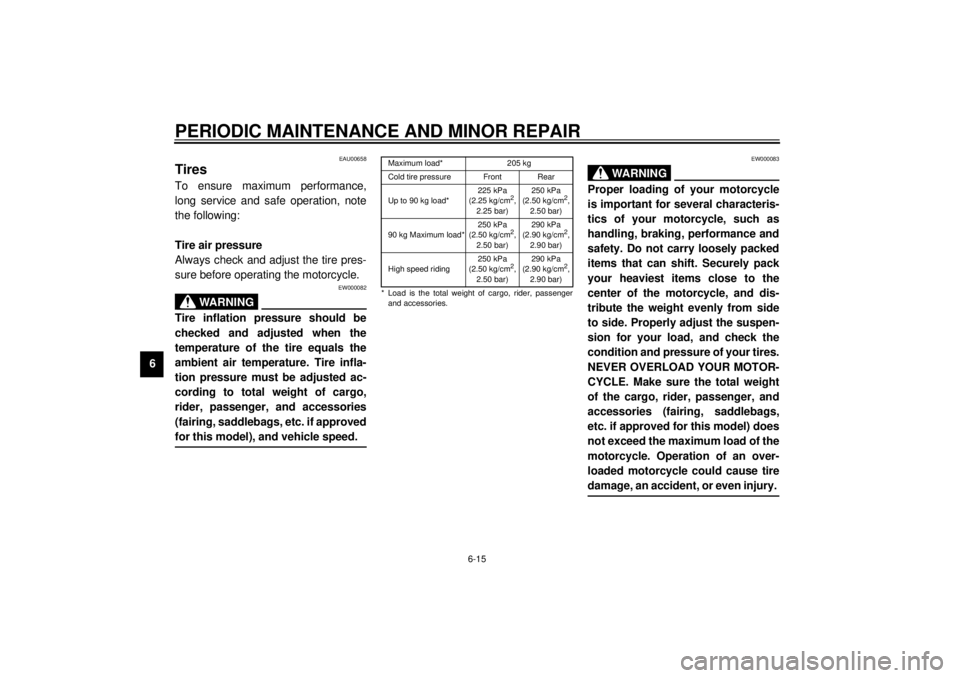
PERIODIC MAINTENANCE AND MINOR REPAIR
6-15
6
EAU00658
TiresTo ensure maximum performance,
long service and safe operation, note
the following:
Tire air pressure
Always check and adjust the tire pres-
sure before operating the motorcycle.
EW000082
WARNING
@ Tire inflation pressure should be
checked and adjusted when the
temperature of the tire equals the
ambient air temperature. Tire infla-
tion pressure must be adjusted ac-
cording to total weight of cargo,
rider, passenger, and accessories
(fairing, saddlebags, etc. if approved
for this model), and vehicle speed. @
CE-33EEW000083
WARNING
@ Proper loading of your motorcycle
is important for several characteris-
tics of your motorcycle, such as
handling, braking, performance and
safety. Do not carry loosely packed
items that can shift. Securely pack
your heaviest items close to the
center of the motorcycle, and dis-
tribute the weight evenly from side
to side. Properly adjust the suspen-
sion for your load, and check the
condition and pressure of your tires.
NEVER OVERLOAD YOUR MOTOR-
CYCLE. Make sure the total weight
of the cargo, rider, passenger, and
accessories (fairing, saddlebags,
etc. if approved for this model) does
not exceed the maximum load of the
motorcycle. Operation of an over-
loaded motorcycle could cause tire
damage, an accident, or even injury. @
Maximum load* 205 kg
Cold tire pressure Front Rear
Up to 90 kg load*225 kPa
(2.25 kg/cm
2,
2.25 bar)250 kPa
(2.50 kg/cm
2,
2.50 bar)
90 kg Maximum load*250 kPa
(2.50 kg/cm
2,
2.50 bar)290 kPa
(2.90 kg/cm
2,
2.90 bar)
High speed riding250 kPa
(2.50 kg/cm
2,
2.50 bar)290 kPa
(2.90 kg/cm
2,
2.90 bar)
* Load is the total weight of cargo, rider, passenger
and accessories.
Page 62 of 97
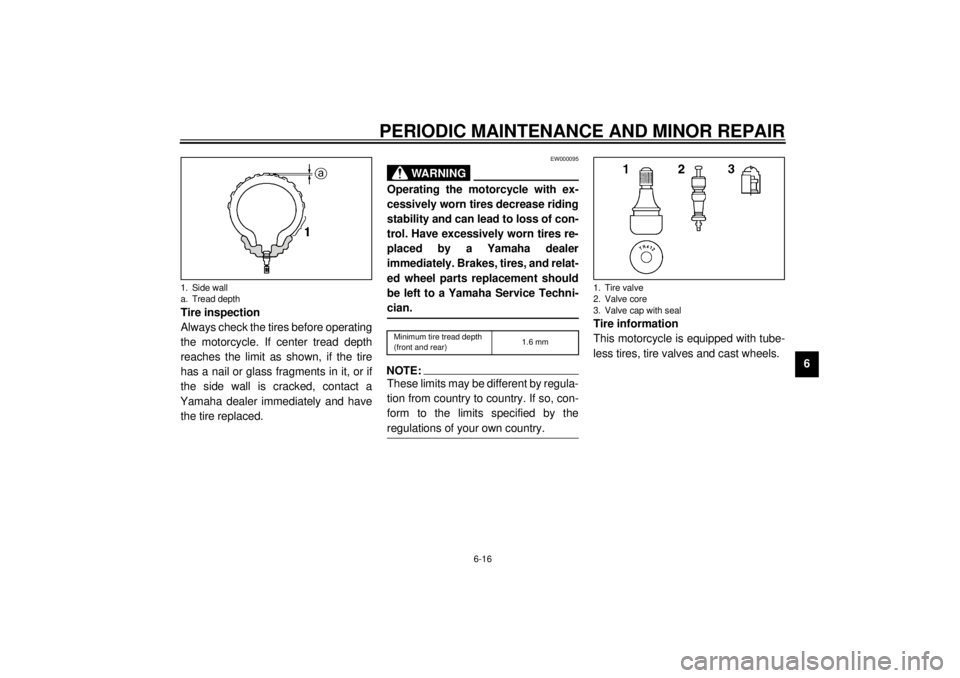
PERIODIC MAINTENANCE AND MINOR REPAIR
6-16
6 Tire inspection
Always check the tires before operating
the motorcycle. If center tread depth
reaches the limit as shown, if the tire
has a nail or glass fragments in it, or if
the side wall is cracked, contact a
Yamaha dealer immediately and have
the tire replaced.
EW000095
WARNING
@ Operating the motorcycle with ex-
cessively worn tires decrease riding
stability and can lead to loss of con-
trol. Have excessively worn tires re-
placed by a Yamaha dealer
immediately. Brakes, tires, and relat-
ed wheel parts replacement should
be left to a Yamaha Service Techni-
cian. @CE-26ENOTE:@ These limits may be different by regula-
tion from country to country. If so, con-
form to the limits specified by the
regulations of your own country. @
Tire information
This motorcycle is equipped with tube-
less tires, tire valves and cast wheels.
1. Side wall
a. Tread depth
Minimum tire tread depth
(front and rear)1.6 mm
1. Tire valve
2. Valve core
3. Valve cap with seal
Page 63 of 97
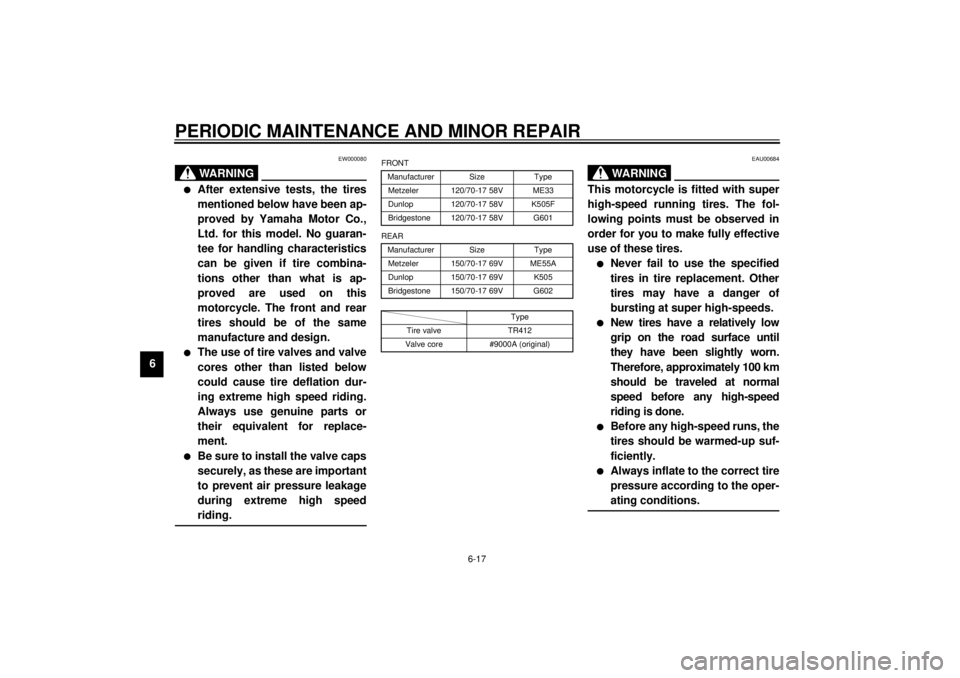
PERIODIC MAINTENANCE AND MINOR REPAIR
6-17
6
EW000080
WARNING
@ l
After extensive tests, the tires
mentioned below have been ap-
proved by Yamaha Motor Co.,
Ltd. for this model. No guaran-
tee for handling characteristics
can be given if tire combina-
tions other than what is ap-
proved are used on this
motorcycle. The front and rear
tires should be of the same
manufacture and design.
l
The use of tire valves and valve
cores other than listed below
could cause tire deflation dur-
ing extreme high speed riding.
Always use genuine parts or
their equivalent for replace-
ment.
l
Be sure to install the valve caps
securely, as these are important
to prevent air pressure leakage
during extreme high speed
riding.
@
CE-10E
CE-12EEAU00684
WARNING
@ This motorcycle is fitted with super
high-speed running tires. The fol-
lowing points must be observed in
order for you to make fully effective
use of these tires.l
Never fail to use the specified
tires in tire replacement. Other
tires may have a danger of
bursting at super high-speeds.
l
New tires have a relatively low
grip on the road surface until
they have been slightly worn.
Therefore, approximately 100 km
should be traveled at normal
speed before any high-speed
riding is done.
l
Before any high-speed runs, the
tires should be warmed-up suf-
ficiently.
l
Always inflate to the correct tire
pressure according to the oper-
ating conditions.
@
FRONT
Manufacturer Size Type
Metzeler 120/70-17 58V ME33
Dunlop 120/70-17 58V K505F
Bridgestone 120/70-17 58V G601
REAR
Manufacturer Size Type
Metzeler 150/70-17 69V ME55A
Dunlop 150/70-17 69V K505
Bridgestone 150/70-17 69V G602
Type
Tire valve TR412
Valve core #9000A (original)
Page 64 of 97
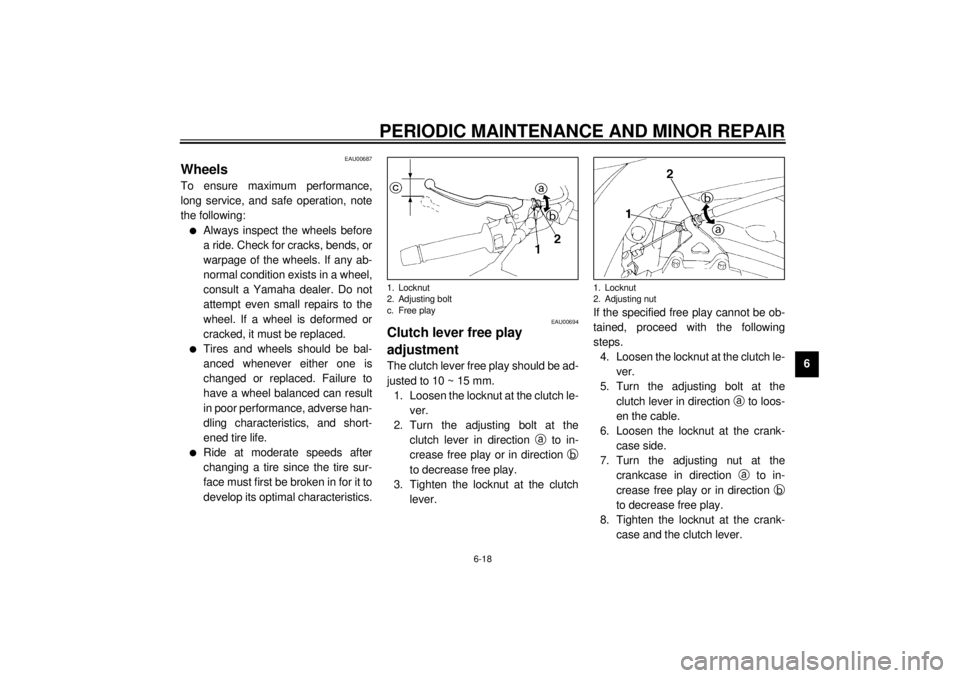
PERIODIC MAINTENANCE AND MINOR REPAIR
6-18
6
EAU00687
WheelsTo ensure maximum performance,
long service, and safe operation, note
the following:l
Always inspect the wheels before
a ride. Check for cracks, bends, or
warpage of the wheels. If any ab-
normal condition exists in a wheel,
consult a Yamaha dealer. Do not
attempt even small repairs to the
wheel. If a wheel is deformed or
cracked, it must be replaced.
l
Tires and wheels should be bal-
anced whenever either one is
changed or replaced. Failure to
have a wheel balanced can result
in poor performance, adverse han-
dling characteristics, and short-
ened tire life.
l
Ride at moderate speeds after
changing a tire since the tire sur-
face must first be broken in for it to
develop its optimal characteristics.
EAU00694
Clutch lever free play
adjustmentThe clutch lever free play should be ad-
justed to 10 ~ 15 mm.
1. Loosen the locknut at the clutch le-
ver.
2. Turn the adjusting bolt at the
clutch lever in direction
a to in-
crease free play or in direction
b
to decrease free play.
3. Tighten the locknut at the clutch
lever.If the specified free play cannot be ob-
tained, proceed with the following
steps.
4. Loosen the locknut at the clutch le-
ver.
5. Turn the adjusting bolt at the
clutch lever in direction
a to loos-
en the cable.
6. Loosen the locknut at the crank-
case side.
7. Turn the adjusting nut at the
crankcase in direction
a to in-
crease free play or in direction
b
to decrease free play.
8. Tighten the locknut at the crank-
case and the clutch lever.1. Locknut
2. Adjusting bolt
c. Free play
1. Locknut
2. Adjusting nut
Page 83 of 97
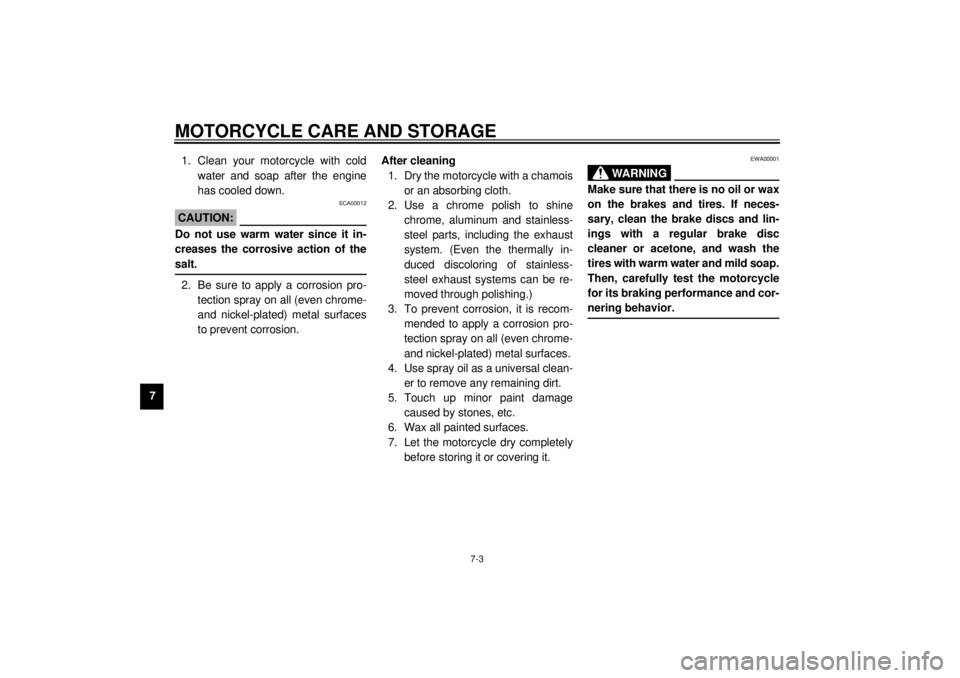
MOTORCYCLE CARE AND STORAGE
7-3
71. Clean your motorcycle with cold
water and soap after the engine
has cooled down.
ECA00012
CAUTION:@ Do not use warm water since it in-
creases the corrosive action of the
salt. @2. Be sure to apply a corrosion pro-
tection spray on all (even chrome-
and nickel-plated) metal surfaces
to prevent corrosion.After cleaning
1. Dry the motorcycle with a chamois
or an absorbing cloth.
2. Use a chrome polish to shine
chrome, aluminum and stainless-
steel parts, including the exhaust
system. (Even the thermally in-
duced discoloring of stainless-
steel exhaust systems can be re-
moved through polishing.)
3. To prevent corrosion, it is recom-
mended to apply a corrosion pro-
tection spray on all (even chrome-
and nickel-plated) metal surfaces.
4. Use spray oil as a universal clean-
er to remove any remaining dirt.
5. Touch up minor paint damage
caused by stones, etc.
6. Wax all painted surfaces.
7. Let the motorcycle dry completely
before storing it or covering it.
EWA00001
WARNING
@ Make sure that there is no oil or wax
on the brakes and tires. If neces-
sary, clean the brake discs and lin-
ings with a regular brake disc
cleaner or acetone, and wash the
tires with warm water and mild soap.
Then, carefully test the motorcycle
for its braking performance and cor-
nering behavior. @